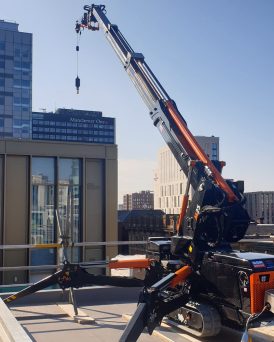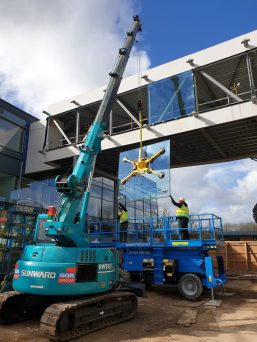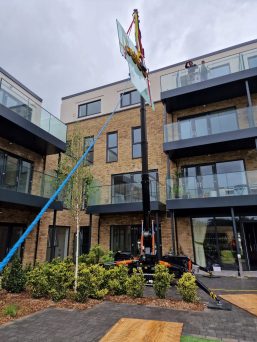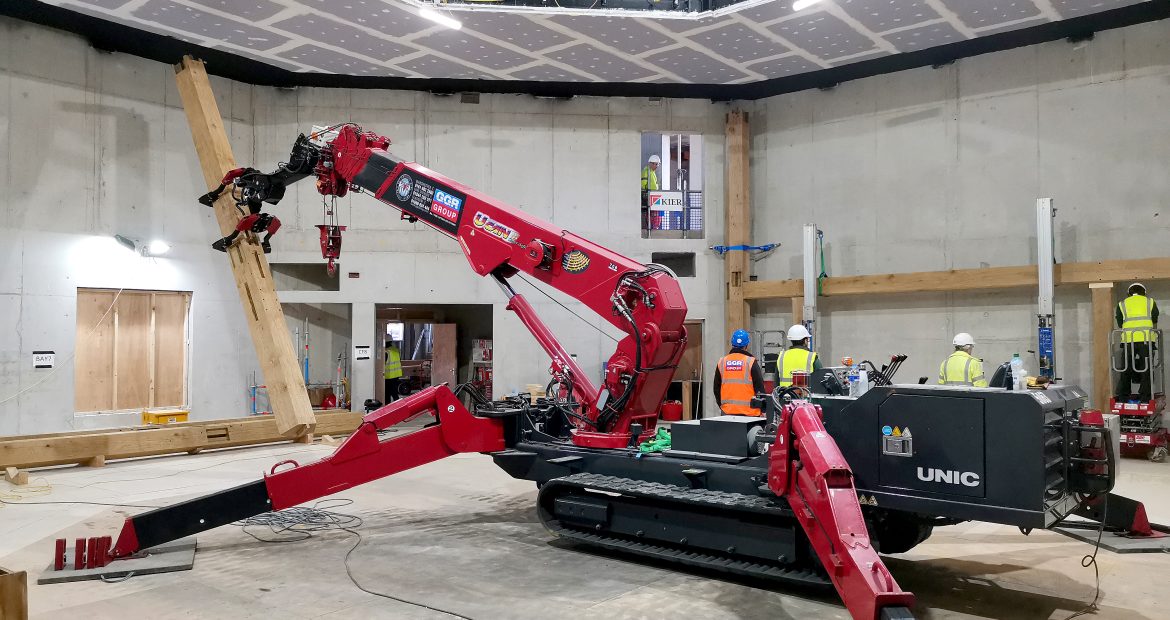Cranes are some of the most powerful and useful machines in the construction industry, having a use for almost any job that requires a lift. However, these amazing machines come with plenty of danger, as their large size and strength can easily destroy property and injure people which is why safety procedures and laws are in place to reduce the possibility.

GGR Group’s TMC25 Articulated Crawler Crane overlooking Manchester on a roof.
At GGR Group we have decades of experience with handling cranes safely and have the expert knowledge needed to develop new technology that will improve your crane safety experience. Below we have put together our 10 top tips for crane safety.
Crane Safety Top Tips
Cranes in modern times have been designed with complete safety in mind which is why oftentimes crane accidents are caused by human error, just take a look at this blog where we discussed images of construction workers performing insane acrobatics on their cranes. In recent statistics, it was found that 10% of fatal injuries in construction were caused by being struck by moving objects and 9% were caused by moving vehicles, both of which cranes likely cause a percentage of.
PPE
Don’t approach a work site with a crane without proper PPE as you can put both your own life and others at risk. Below is our list of minimum safety equipment you should have when operating a crane, but this list may need to be added to depending on the job.
- Hi-vis clothing
- Helmet
- Safety boots
Ground Conditions
Cranes are large and heavy so the reality is that any slight change in ground conditions can have a massive effect on the machine. Ground that is too soft can cause the crane to sink or any rough terrain can cause a crane to tip or get stuck.
There are cranes designed to be used on rough terrain such as our MCC1004 Mini Crawler Crane which has a ±21˚ gradeability. Always check what the ground conditions will be so you can be sure to choose the right crane for the job and avoid wasting time or causing accidents.
Weather
While cranes are sturdy machines performing any sort of lift in bad weather can cause all sorts of problems, such as the load swinging in the wind and hitting something or rain causing impaired vision making it unsafe to use it. Hot weather can cause both you and the crane to overheat. Cold weather can also cause the steel in cranes to become brittle, making it unsafe to use.
We go more in-depth in our blog on ‘Crane Safety During Winter’ where we have made sure to cover all the different winter weather types.

GGR Group’s MCC500D Mini Crawler Crane lifting glazing.
Risk Assessment/Lift Plan
These are both a massively important part of crane safety as this is where you can address any foreseeable risks and how you can overcome them. The lift plan is a legal requirement which must be done by a competent person as in performing it you shall negate all of the clear risks involved and ensure the lift can be performed safely.
If you need any help with your lift plan learn more here.
Surrounding Hazards
Hazards can include anything such as loose ground in the area that can be prone to landslides, objects in the way (movable or immovable), chemicals, or powerlines. You should always be on the lookout for hazards even after a lift plan has been made as hazards can develop over time or very suddenly.
Crane Inspection
This is one of the most vital parts to crane safety as without a safe crane how can you perform a lift safely? You should follow government legislation and LOLER which state cranes should be thoroughly inspected before use, after assembly, regularly while in service (regularity can change depending on conditions), and in exceptional circumstances such as damage and failure, lack of use for long periods, and major changes which can effect the equipment’s integrity.
Powerlines
Powerlines are everywhere you look and are perhaps some of the hardest hazards to work around as they can’t be moved and usually can’t be turned off. Due to the steel composition of a crane it means they are very conductive and do not have to be touching a cable for the electricity to run through the crane.
Mats and Cribbing
With how heavy cranes are you should makes sure you are using the correct outrigger mats and cribbing to prevent the outriggers from sinking or failing

GGR Group’s TMC25 Articulated Crawler Crane installing glass.
during a lift. The use of these distributes the weight of the crane to prevent sinking and provides a more stable surface.
Enclose the Hoist Way
Any pedestrians or unneeded staff should not be able to accidentally walk into the hoist way, especially when a lift is taking place. You should cordon off the area using traffic barriers, cones, and bright barrier tapes which clearly convey that the public should not enter the area.
Mobile Phones and Other Distractions
When in an area of crane operation or operating it yourself you should not be distracted as you can endanger yourself and others. When focused on your mobile phone or other things you can easily miss hazards and pedestrians and potentially hit them with your crane or cause other expensive accidents such as damage to a building.
If you need further advice on crane safety GGR Group are happy to help as a go to plant hire company that is no.1 for lifting solutions. GGR has CAD expertise and offers lift plans as well as crane operator hire to help you complete any job. However, if you would like to be able to operate a crane yourself without our help you can also sign up to one of our many accredited training programmes for cranes and other plant machinery. To speak to one of our experts you can call us or contact us here.
Trackback URL: https://www.ggrgroup.com/news/top-tips-for-crane-safety/trackback/
